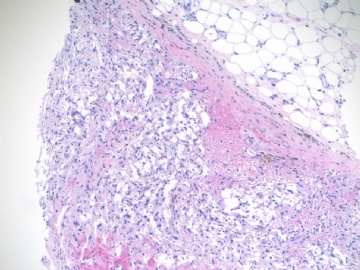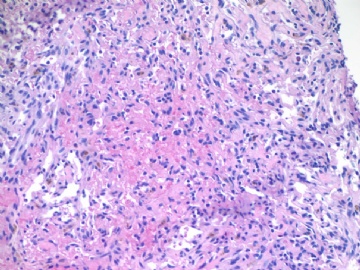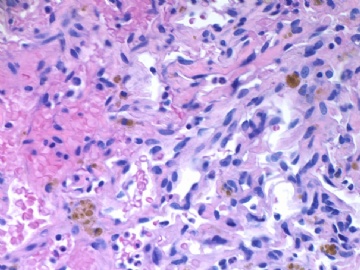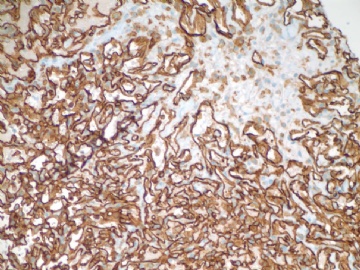| 图片: | |
|---|---|
| 名称: | |
| 描述: | |
- B1820乳房不典型血管瘤( cqz-20)
| 姓 名: | ××× | 性别: | 年龄: | ||
| 标本名称: | |||||
| 简要病史: | |||||
| 肉眼检查: | |||||
About 50 y/f breast core bx.
Immaging showed a 0.7x0.5 cm demarcated abnormal area.
F1,100x, demostrating the margins
F2-3 200x
F4-5 400x
F6 CD31stain
F7 CD34 stain
-
本帖最后由 于 2009-07-18 09:31:00 编辑
相关帖子
-
本帖最后由 于 2009-06-07 17:47:00 编辑
I remeber we had a breast vascular lesion case in this web with a lot of debatable discusion.
Above is a my case three weeks ago. Patient has no cancer or radiation history. She did have a breast core biopsy in the same breast two years ago. The diagosis was small papilloma and ducatal hyperplsia. I reviewed the previous breast core slides and agree with the interpretation. I called the radiologist to review the current and previous imaging films to confirm current lesion and the biopsy lesion two years ago were different areas. I felt difficult to sign out the breasst core biopsy case. Just wonder how you guys would sign out the case if it were yours.
I am on service for FNA on site evaluation for surgeons (several lung mass patients) this weekend. Now we are waiting for patient and I have time to send you this case. Enjoy your weekend
cz
quyibl译:
我记得网上有过一个存在很大争议的乳腺血管性病变的病例。
上面这个是我三周前的一个病例。病人没有乳腺癌或放射线照射史。两年前同侧乳腺做过活检,诊断是小的乳头状瘤伴导管增生。我复习了原先的乳腺活检切片,同意当时的诊断。我请放射科医师复验现在和原先的影像片,确定两次病变不在同一位置。我感到签出这个病例很困难,非常想知道如果这是你的病例,你会怎么签发这个报告。
这个周末, 我在为外科医生做现场的FNA(几个肺部包块的病人),现在正在等待病人,所以有时间发送给你们这个病例。 周末愉快!cz
The overall features still favour a benign vascular lesion. Dr Zhao, could you please give us an exact Ki67 count?
At this stage, I would sign out report like this: A vascular lesion with atypical features, favour a hemangioma. Complete excision of lesion with clear margins is recommanded.
Luckily, I cannot sign out report independently right now. But I really want to know, whether this report will cause trouble.
By the way, Dr Zhao, did you do pericytes stain? What do you think about the use of it in differentiating benign from malignant tumours?
| 以下是引用漫游人在2009-6-17 7:47:00的发言:
The overall features still favour a benign vascular lesion. Dr Zhao, could you please give us an exact Ki67 count? At this stage, I would sign out report like this: A vascular lesion with atypical features, favour a hemangioma. Complete excision of lesion with clear margins is recommanded. Luckily, I cannot sign out report independently right now. But I really want to know, whether this report will cause trouble. By the way, Dr Zhao, did you do pericytes stain? What do you think about the use of it in differentiating benign from malignant tumours? 总体特征仍然倾向良性血管性病变。赵博士,请你给出Ki-67精确值好吗? 在这种情况,我会这样发报告:伴有不典型特征的血管性病变,考虑血管瘤。建议完整手术切除。 幸运的是,我现在还不能独立发报告。但我很想知道我这样发报告有没有麻烦。顺便问一下赵博士,你做周细胞染色吗?你会考虑用它区分良性与恶性肿瘤吗? |
-
本帖最后由 于 2009-06-17 10:41:00 编辑
Thank you all for your input and Dr. Huang's translation.
To answer 漫游人:
I have never used pericyte stain. You can share your knowledge if you used the stain.
Ki67 positive cells should be <5%.
You said you cannot sign out case indipendently. Are you a reisident or fellow? I like your discussion a lot. You like an experienced pathologists.
Welcome to share your knowledge here.
Thank you Dr Zhao for your encouragement. If I were in China, I would be in the position of signing out report. I'm currently in overseas and trying to get through their training programe. I really liked your cases and the way you were presenting them. It's very educative.
I had my residence training in china that was very different from my current training and definately your training in America. We were trained to do spot diagnosis on almost any situation and were not used to give differential diagnosis on no matter a difficult case or a straight forward case. So if I didn't know an answer, i could not even give an alternative. Even today, I still have the problem sometimes.
I think the situation is better in major hospitals. I believe the general situation will improve gradually especially through this education platform.
We were trained to do spot diagnosis on almost any situation and were not used to give differential diagnosis on no matter a difficult case or a straight forward case. So if I didn't know an answer, i could not even give an alternative.
实话啊……
像我这样的刚入行的人遇到的最大的问题就是这个
一旦有疑难的
就老虎啃天了……

- 赚点散碎银子养家,乐呵呵的穿衣吃饭
Thank 漫游人's introduction.
I heard the spot diagnosis is for clinical patholgy, such as some blood work, urine exam. I never heard its usage in surgical patholog. Anatomic pathology related issues include frozen, on site evaluation in fine needle aspiration.
I am 孤陋寡闻. spot dx for surgical specimen is not easy, but you can get train well for your logic thinking.
Anyway, thank for share.
-
本帖最后由 于 2009-07-08 22:47:00 编辑
Ok. I am telling the story about this case.
Again I am gynecologic/breast pathologist and know a little about soft tissue tumors. I check a lot books and classic photos for vascular lesions when I had the case. The sections of the lesion demonstrate anastomosing vascular channels, endothelial cells nuclei with mild atypia and some with hyperchromatic. Solid and spindle cell foci are present. My cases are very similar to some of the angiosarcoma photos in Rosen breast book. I felt that it was an angiosarcoma case. I showed my case in our daily slide review conference. Our chief (about twenty hospitals in UPMC; all pathologist belong one large dept; we have one dept Chair; the haeds in pathology dept in each hospital are called chiefs or directors) and some pathologists agreed my angiosarcoma dx. My chief thought it was sarcoma without any question and would like to co-sign the case with me. I discussed the case with primary doctor of the patient and suggested the patient should see the breast sugeon. So I released the case as angiosarcoma-low grade with a long comment at 6 0'clock in the same day. We release case electronically in the computer. The related physicians will receive the pathology reports very quickly by automatical fax system when we release the case in computer. Also we cannot change the reports by ourselve after the cases were signed out.
njwbhuang译:
好了,我现在告诉你有关这个病例的故事
再次声明,我是一个妇科/乳腺病理医生,对软组织肿瘤知之甚少。当我遇到这个病例时,我查阅了许多书和典型图片。该病例切片显示有相互沟通的血管网,轻度不典型的内皮细胞核,部分细胞核深染。可见灶性实性和梭形细胞区域。我的病例非常相似于Rosen乳腺书中的一些血管肉瘤的图片。我认为这例应该是血管肉瘤,并将本例提交到科室每天病理读片会上。我们的主任(UPMC有20家医院,所有的病理医生属于一个大的病理科,我们有一个病理科主席,每个医院病理科的头子称为主任)和一些医生同意我的血管肉瘤的诊断。我的主任认为它是肉瘤没有问题,并且愿意与我一同签发这个报告。我与这个病人的初诊医生进行了沟通,建议这个病人应看乳腺外科医生。我在同一天6点签发了低级别血管肉瘤的病理报告,并写了一个较长的注解。我们在电脑上发报告。相关医生将很快通过自动传真系统收到病理报告。而且我们在报告发出后不能对报告进行修改。
-
本帖最后由 于 2009-07-08 22:51:00 编辑
I discussed and convinced my chief. I went to the quality control office to ask the person to change my diagnosis (all changes of pathology report must be made by them). I called the primary physician again to notice the change of the report and the reasons. Finally I released the changed dx report----Atypical vascular lesion with a long comment, excisional biopsy suggested for definitive dx.
I feel good to call atypical vascular lesion for this core biopsy case. If it is a sarcoma by excisional bx pt can have mastectomy in next procedure. If it is still borderline lesion in excisional bx, the pt can avoid total mastectomy.
What lessions I have learned from this case (also suggestion to young pathologists in China):
1. Think over for some difficult case, especially for the subspecielty you are not famililar. Do not rush yourself. Keep one day and you may have different oppinion for your case in the second day.
2. You must be 100% sure or agree the dx before you release your cases. No matter what other people say, your chief, your chair, consulting exports. You will take the responsibility when your name is prsent in the pathology report.
3. Consider the possible follow-up procedures the clinicians will take when you make your dx.
If this were a mastectomy case, I will send the case to soft tissue expert pathologists for the second oppinion.
Ok, I think I complete the presentation and discussion for this case. Thank all of you for reading and discussing for this case.
cz
njwbhuang译:
我与主任讨论并是他信服了。我去质控办公室请一个人帮我改变我的病理诊断(所有病理报告修改必须由他们完成)。我再次打电话给初诊医生,提醒他我们修改了病理诊断并说明了理由。最后我签发了一个修改的病理报告——不典型血管性病变,并有一个长的注解,建议切开活检以明确诊断。我对这例粗针活检病例称为不典型血管病变比较满意。如果切开活检证实为肉瘤,病人ke 下一步进行乳腺切除术。如果仍然是交界性病变,那病人可免除乳腺全切除术。
从这个病例我吸取的教训是(也是对中国年轻医师的建议):
1.认真考虑一些疑难病例,特别是你不熟悉的亚专业病例。发报告不要急,保留一天,第二天你可能有不同的意见。
2.在发报告前你必须有100%把握或同意你的诊断。无论什么人如科主任、主席、会诊转接等告诉你什么,你要对病理报告中你的名字负责。
3.当你做出诊断时,你要想到临床医生将要可能采取的措施。如这个病例是乳腺部分切除,我将把这个病例送到软组织病理医生那里,看看他们的诊断。
好了,我想我完成了这个病例的介绍和讨论。谢谢所有参与这个病理的讨论者。
-
本帖最后由 于 2009-07-08 22:53:00 编辑
-
Department of Pathology, Memorial Sloan-Kettering Cancer Center, New York, New York 10021.
Eighteen patients with vascular tumors of the breast that exhibited characteristics raising the question of but not qualifying for a diagnosis of low-grade angiosarcoma were reviewed. We had previously referred to these lesions as "atypical" hemangiomas because of concern regarding the diagnosis and the risk of the later development of angiosarcoma. Significant features, variably present, included small size (less than 2.0 cm), relative circumscription, broadly anastomosing vascular channels, and endothelial hyperplasia. Destructive invasion, solid areas, and hemorrhage or necrosis unrelated to a needle localization procedure were absent. Four distinct histological patterns were observed: cavernous, compact capillary, capillary budding, and a combined cavernous and compact capillary type. The age of the patients varied from 19 to 82 years (mean 60 years). Eleven tumors were detected mammographically. The size of the lesion ranged from 0.4 to 2.0 (mean 0.9) cm. The diagnostic biopsy was the only treatment in nine (50%) cases. Reexcision was performed in seven and mastectomy was done in two cases. Follow-up ranged from 1 to 140 (mean 44) months. There have been no local or systemic recurrences. Hemangiomas with diverse histological patterns have been detected clinically with the increasingly widespread use of mammography. Further follow-up indicates that the lesions originally referred to as "atypical" are benign and not associated with an appreciable risk of the development of angiosarcoma. Complete excision alone is recommended to treat these tumors, which may be diagnosed as hemangiomas and subclassified according to growth pattern
njwbhuang译:
伴有不典型组织学特征的乳腺血管瘤:证实它们良性特征的组织学亚型的进一步分析
对18例组织学形态显示有疑问但未符合低级别血管肉瘤诊断的乳腺血管性肿瘤进行复习。由于担心这个诊断和以后发展成血管肉瘤的风险,我们以前将这些病变称为“不典型”血管瘤。有意义的组织学特征如病变小(不到2.0cm)、相对境界清楚、广泛相互沟通的血管网和内皮细胞增生等不同程度存在,而破坏性浸润、实性区域,与穿刺无关的出血或坏死均未见。可有4种独特的组织学构型:海绵状、致密毛细血管、毛细血管芽和复合性海绵状和致密毛细血管型。病人年龄19-82岁(平均60岁)。11个病例行乳腺摄影检查。病变大小从0.4到2.0cm(平均0.9cm)。9例(50%)行诊断活检并作为唯一治疗方法。7例行肿块再次切除,2例行乳腺切除术。随访时间1到140月(平均44月)。没有局部或全身复发。随着乳腺摄影逐渐广泛使用,伴不同组织学构型的血管瘤临床上检出率增加。深入随访显示当初称为“不典型”的这些病变是良性,与发展成血管肉瘤的已知的风险无关。这些肿瘤可诊断为血管瘤和根据生长构型而确定的亚分类,并建议将肿块单独完整切除。
Am J Surg Pathol. 1992 Jun;16(6):553-60.
Hemangiomas of the breast with atypical histological features. Further analysis of histological subtypes confirming their benign character.
-
本帖最后由 于 2009-07-08 22:58:00 编辑
Histopathology. 2008 Jan;52(1):30-44.
-
Vascular proliferations of the breast.
Department of Histopathology, University College Hospital, Galway, Ireland. cmbrodie@gmail.com
Vascular proliferations of the breast are uncommon but potentially diagnostically challenging lesions. Clinically apparent processes are more likely to be malignant; however, a range of benign entities which must be differentiated from angiosarcoma also exists. This review discusses first, breast lesions of apparent vascular origin, then benign and histologically bland perilobular, cavernous and capillary haemangiomas. Subsequently, more diagnostically challenging, atypical haemangiomas, papillary endothelial hyperplasia, angiomatosis and angiolymphoid hyperplasia with eosinophilia (epithelioid haemangioma) are considered. In addition, lesions with low-grade malignant potential such as haemangiopericytomas and epithelioid haemangioendotheliomas may rarely present in the breast. However, primary angiosarcomas and radiation-associated vascular lesions are reviewed in depth, as these entities are of greatest clinical and pathological significance.
njwbhuang译:
乳腺的血管增生性病变
乳腺的血管性增生虽然少见,但有可能是在诊断上具有挑战性。临床上表现明显进程的多可能是恶性的,然而一些应与血管肉瘤区分的良性病变也可存在。这篇综述首先讨论了乳腺明显的血管来源的病变,然后介绍了良性和组织学温和的小叶周围、海绵状和毛细血管瘤。接着综述了诊断具有挑战性的病变如不典型血管瘤、乳头状内皮增生、血管瘤并和伴有嗜酸细胞浸润的血管淋巴样增生(上皮样血管瘤)。另外,罕见的低级别恶性潜能型病变如血管外皮细胞瘤和上皮样血管内皮细胞瘤可发生于乳腺。然而,原发性血管肉瘤和放射相关的血管性病变更进一步复习,因为这些疾病具有重要的临床和病理意义。
-
本帖最后由 于 2009-07-08 22:59:00 编辑
Eur J Gynaecol Oncol. 2004;25(3):324-6.
-
Clinicopathological study of vascular tumors of the breast: a series of ten patients with a long follow-up.
Pathology Laboratory, Areteion Hospital, Athens, Greece.
Ten cases of vascular tumors of the breast were examined in our laboratory during the last decade (1992-2001). Nine patients were female and one male (ages 31-77, average 52 years). Six patients presented parenchymal vascular lesions (1 angiosarcoma, 1 atypical hemangioma, 3 perilobular hemangiomas, 1 cavernous hemangioma) measuring 0.5-6 cm in the greatest diameter. Two lesions were accidental findings in lumpectomy specimens excised for fibrocystic disease with microcalcifications. Four patients presented non-parenchymal vascular lesions: three cavermous hemangiomas (one in a male patient) and one angiolipoma measuring 1-6 cm in diameter. All tumors were treated by lumpectomy with the exception of the atypical hemangioma which was treated by simple mastectomy. The patient with the angiosarcoma was treated by simple mastectomy, radiotherapy and chemotherapy and died with disseminated disease three years after initial diagnosis. All other patients are well up to date (follow-up 1-9 years).
njwbhuang译:
乳腺血管性肿瘤临床病理分析:10例系列报道伴长期随访
1992-2001年间我们共遇到10例乳腺血管性肿瘤。女性9例,男性1例(年龄31-77岁,平均52岁)。6例表现为实质血管性病变(血管肉瘤1例,不典型血管瘤1例,小叶周围血管瘤3例,海绵状血管瘤1例),大小0.5-6cm。2例因乳腺纤维囊型病变伴微钙化在切除的标本上偶然发现。4例呈非实质性的血管病变,其中海绵状血管瘤3例(1例为男性),1例为血管脂肪瘤,最大直径为1.6cm。除了不典型血管瘤性单纯型乳腺切除术外,所有肿瘤均行肿块切除术。血管肉瘤病人行单纯性乳腺切除术、放疗和化疗,在初次诊断后3年死于全身扩散。所有其他病人随访到现在均无异常(随访时间1-9年)。
-
本帖最后由 于 2009-07-08 22:59:00 编辑
Breast. 2002 Aug;11(4):357-8.
-
Breast hemangioma mimicking carcinoma.
Department of Radiology, Hospital Universitari Germans Trias i Pujol, Badalona, Spain. mariscal@ns.hugtip.scs.es
Breast hemangiomas are rare, and usually appear as well-delimited round or oval nodules at mammography. We report a case of a woman with a breast hemangioma, which mammographic features simulated malignancy, and present its pathologic correlation. Hemangiomas are benign vascular tumors that are rarely present in the breast, usually found incidentally on microscopy of biopsy material for other. They are occasionally detected by mammography, presenting as well-delimited round, lobulated nodules, sometimes with calcifications. We present the mammographic findings and pathologic correlation in a case of breast hemangioma with an atypical radiological manifestation, simulating a carcinoma. To our knowledge, this is the first reported case with these radiologic characteristics.
njwbhuang译:
类似于癌的乳腺血管瘤
乳腺血管瘤非常罕见,乳腺摄影上通常表现为境界清楚的圆形或卵圆形结节。我们报道了1例乳腺血管瘤,乳腺摄影特征像恶性,并提供了其病理学特征。血管瘤是良性血管性肿瘤,发生于乳腺比较罕见,通常因其他病变而活检的材料上镜下偶然发现。他们偶在乳房x线摄影术上偶然发现,表现为境界清楚圆形、分叶状结节,有时伴有钙化。我们介绍了1例有不典型放射学特征,类似于癌的乳腺血管瘤的乳房x线摄影术发现和病理特征。据我们所知,这是首例伴有这些放射学特征的乳腺血管瘤病例报道。
-
本帖最后由 于 2009-07-08 23:00:00 编辑
Diagn Cytopathol. 2001 Mar;24(3):215-8.
-
Atypical hemangioma of the breast: a diagnostic pitfall in breast fine-needle aspiration.
Department of Pathology and Laboratory Medicine, Hahnemann University Hospital, MCP Hahnemann University, Philadelphia, Pennsylvania 19102, USA.
We report on the fine-needle aspiration (FNA) cytology of atypical hemangioma of the breast in a 52-yr-old female. The patient presented with a 2-cm palpable left breast mass. An FNA of the mass was performed following a mammogram, corresponding to the palpable breast mass. The FNA demonstrated the presence of numerous atypical single spindle cells scattered throughout a hemorrhagic background. An unequivocal diagnosis of malignancy was not rendered in this case. However, the degree of cytologic atypia suggested a malignant process, and a recommendation for an excisional biopsy was made. Atypical hemangioma should therefore be included in the differential diagnosis of angiosarcoma and other benign and malignant spindle-cell lesions of the breast encountered on cytologic samples.
njwbhuang译:
乳腺不典型血管瘤:乳腺细针吸取诊断中的缺陷
我们报道了1例发生于52岁女性乳腺的不典型血管瘤的细针吸取细胞学(FNA)检查。病人表现为左侧乳腺2cm的可触及的肿块。在行乳腺X线摄影检查术后进行了肿块的FNA。FNA证实了多量不典型单个梭形细胞散在于出血性背景中。对这个病例没有做出明确的恶性诊断。然而,细胞学不典型程度提示恶性过程,建议肿块切除活检。不典型血管瘤因此应包括在血管肉瘤的鉴别诊断中,在细胞学标本中可遇到其他乳腺良性和恶性梭形细胞病变。
-
本帖最后由 于 2009-07-08 23:01:00 编辑
Am J Surg Pathol. 1985 Jul;9(7):491-503.
-
Vascular tumors of the breast. II. Perilobular hemangiomas and hemangiomas.
Nearly 100 vascular tumors of the breast have been studied. Sixty-two were angiosarcomas lesions. Twenty-four patients with mammary hemangiomas are the subject of this report. Five of 11 microscopic perilobular hemangiomas, not clinically apparent (2 mm or less), were atypical and had nuclear hyperchromasia or focal anastomoses among vascular channels. Whether treated by excision or mastectomy, all 11 patients remain well with follow-up of up to 10 years. Fourteen clinically or grossly apparent macroscopic hemangiomas (0.3-2.5 cm) included eight characterized as cytologically atypical. With one exception, lesions designated hemangiomas were well circumscribed and tended to be divided into lobules. In more than half, origin from large, non-neoplastic "feeding" vessels that were seen branching into the lesion was demonstrated. Whether treated by excision or mastectomy, no hemangioma has recurred after follow-up, up to 5 years in some cases. The diagnosis of vascular tumors of the breast requires thorough microscopic study of the entire lesion. The majority are angiosarcomas. However, about one-third constitute a spectrum of apparently benign and atypical lesions, in which the single largest group are perilobular hemangiomas and hemangiomas. Size appears to be an important characteristic for distinguishing hemangiomas from angiosarcomas, as few lesions larger than 2 cm qualify as hemangiomas, whereas angiosarcomas are rarely smaller than 2 cm. It is possible that atypical perilobular hemangiomas or atypical hemangiomas are precursors to angiosarcoma, but this relationship remains to be demonstrated.
njwbhuang译:
乳腺血管性肿瘤Ⅱ.小叶周围血管瘤和血管瘤
仅100例乳腺血管性肿瘤被研究。62例是血管肉瘤,24例乳腺血管瘤是本文研究的主题。11例临床不明显的(2mm及以下)、镜下小叶周围血管中,5例呈不典型性,有核深染或局灶性相互沟通的血管网。无论是切开还是乳腺切除标本,所有11例在随访到10年时间里均无异常。14例临床上或大体明显的血管瘤(0.3-2.5cm)中,8例特征性的有细胞学不典型性。1例血管瘤病变境界清楚,呈小叶状。超过一半病例可见病变来自于大的,非肿瘤性“滋养”血管,这些血管呈分枝状进行病变内。无论是切开还是乳腺切除标本,在随访期内没有血管瘤复发,部分病例随访到5年。乳腺血管性肿瘤的诊断需要整个病变全部镜下观察。大多数是血管肉瘤,然而,约1/3为明显良性和不典型病变,单个最大组是小叶周围血管瘤和血管瘤。病变大小似乎是血管瘤与血管肉瘤区分的一个重要特征,因为仅有少数>2cm病变是血管瘤,而血管肉瘤很少大于2cm。不典型小叶周围血管瘤或不典型血管瘤可能是血管肉瘤的前驱病变,但这种相关性尚需要进一步证实。





















